First Flight:
Dan Garn & Wendell Taylor
![]()
First Flight:
|
|
by Alfred Scott
This article appeared in the September 1987 issue of the Falco Builders Letter. |
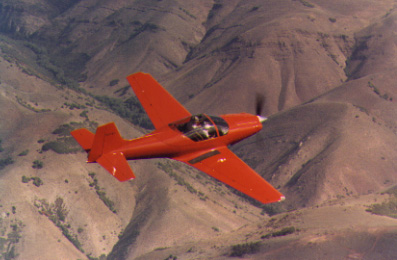
The first 180 hp Falco has flown. Built by Dan Garn and Wendell Taylor of Salt Lake City, Utah, the plane flew for the first time on July 16, 1987 from Bountiful Sky Park field.
When it came time to pick which of the partners was to fly first, Dan deferred to Wendell, who has owned a Pitts S2A for a number of years and had flown with Larry Wohlers a couple of years ago. With all of the initial ground runs and taxi tests out of the way, Wendell strapped in. The whole process was recorded on video tape, and someone asked Wendell if he had any final words for posterity. "Keep the chewing end up front!" replied Wendell E. Taylor, D.D.S.
Wendell did one last high-speed taxi down the runway and then came back for the big event-a picture-perfect first flight takeoff, pulling the nose up well above stall speed and then climbing out at a shallow angle. Up she flew and circled the airport in a monotonous buzzard-pattern while Wendell felt out the plane. After checking out the low speed handling, Wendell brought the gear up and was rewarded with his first taste of speed. "Wow, that's like taking the brakes off!" the radio crackled as the circular flight pattern suddenly became much larger.
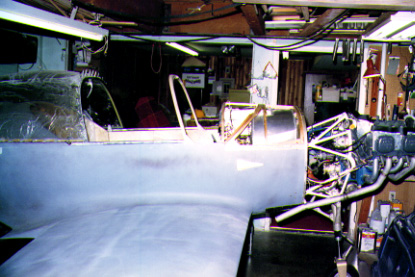
The Falco under construction in Wendell Taylor's basement.
After 20 minutes Wendell lowered the gear and shot a practice approach, going around at a couple of hundred feet before doing a beautiful landing. A friend, Jack Butler, flew it next. They didn't shut off the engine, just traded places and flew the thing. After Jack landed, Dan Garn had his turn.
A great first flight is an uneventful occasion. A stranger watching the whole thing across a fence might have been amused at the sight of three grown men taking turns flying an airplane around in circles above the field. But Wendell reported it was a "thrill of a lifetime" to do the first flight after years of evenings building the plane. The Falco "flew like a dream," he reported. For the last few years Wendell had only flown the Pitts, so he got some time in a Bonanza to reacquaint himself with tricycle gear airplanes. "The directional control on the ground is terrific," he said. "Please tell the other builders that flying the Falco is not a fearful transition from other airplanes."
Falco N69WD (for Wendell and Dan-don't ask!) is painted Ferrari red. White stripes are planned, but they decided to leave that for later. It clearly shows the value of the Lu Matthews paint schemes. In any dark color, the Falco looks short and fat without a stripe down the side. "Generic" is the word Wendell uses.
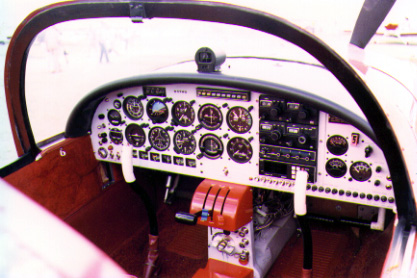
The required 25 hours were flown off just as the Oshkosh show was starting. Jack Butler, who has built three biplanes and worn out three 210's in his 20,000 hours of flying, told Wendell it was "immoral" not to go to Oshkosh with a new homebuilt. Two hours later Jack and Wendell were flying eastbound. They arrived on Monday after a pleasant flight. On the first day, the engine cluster gauges began to get very erratic. They landed and found that the nut for the case ground was sitting on the cockpit floor. That replaced and safetied with a lock nut, the rest of the flight was uneventful.
The Falco has an attractive red interior with a light grey instrument panel, pedestal and nose gear cover. The quadrant cover and the center console covers are red which produces an unexpected contrast. The Falco weighs in at 1,151 lbs which includes dual navcoms, transponder with altitude encoder and a II Morrow loran. At Oshkosh they were having problems with the antenna, and they never really found out what was wrong, but they now attach the antenna coax to the stainless steel canopy rail. This way the canopy frame is used for the loran antenna, and nothing is done to insure that there is a good connection between the canopy track and the canopy frame-it just works.
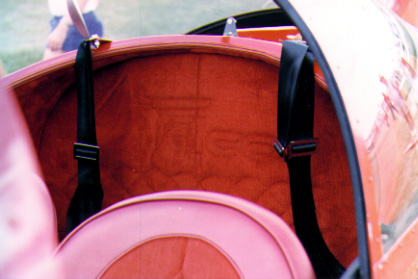
The engine is a Type II dynafocal 180 hp Lycoming which began life with a carburetor on the bottom. After cutting the hole in the bottom of the cowling, Dan and Wendell decided they couldn't stand the sight of a carburetor scoop, so they exchanged the sump for an IO-320-B1A sump, which provides for induction from the aft end, and they installed an Ellison throttle body injector. Thus, the induction system is much like the standard system we use, but with the Ellison device instead of the Bendix fuel injector. The blisters on the cowling are not particularly noticable or objection-able.
The Ellison throttle body injector is an improvement on the Posa/Lake carburetor for VW engine conversions. This type of device is essentially a carburetor that uses a variable venturi instead of a butterfly valve. Fuel is metered from a tube with many small holes and the engine is leaned by rotating the tube so that the holes are turned to the side, thus exposing the fuel to less suction. As it does not have a bowl-and-float, it is suitable for inverted flight-Pitts drivers are the primary users of the system.
Wendell says they have been delighted with the system but don't think they are getting full power. This system is apparently sensitive to turbulence in the induction system and their engine has a slight tendency to run lean. Wendell is also not sure they are getting full manifold pressure, possibly 2" less than maximum.
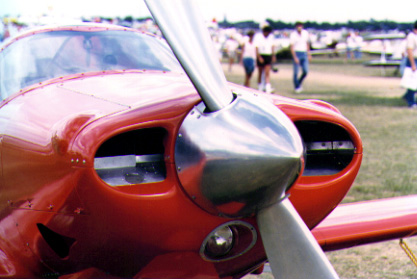
At this time, they have about 65 hours on the Falco and are just enjoying flying the airplane as they slowly get little things the way they want them. They have made no attempt to nail down the performance numbers with any accuracy, but Wendell reports that it climbs at about 1500 fpm at full gross. At 23/2300 in the pattern at Salt Lake City, the plane indicated 160 knots without gear doors. On the trip to Oshkosh the gear doors were installed, and the plane indicated 150 knots at 11,500 feet, which worked out around 200 mph.
Wendell and Dan built the Falco using a few kits but made as much as they could. Dan Garn is an experienced homebuilder and flat likes to make things. He previously built a Midget Mustang and enjoyed the construction of both the aluminum single-seater and the wooden Falco. They spent about 7,000 hours building the Falco.
One construction detail which I questioned was the hinge bolt for the aileron control arm. They used a ball bearing on the control arm and installed no bushings on the two hinges on each side. This puts the quarter-inch bolt in bending rather than shear, and it is substantially weaker than the original design. I asked Dave Thurston what he thought of the change, and Dave was very specific. First, he said the installation has approximately one-fourth the strength of the original design. I asked Dave how he would categorize this change-worrisome, dangerous? Dave said, "Well, I would call it non-airworthy. They shouldn't fly with it like this. It is not safe for flight, and they should ground the airplane until it is fixed." Dave also wanted to know if there were other bolts in bending in the control system.
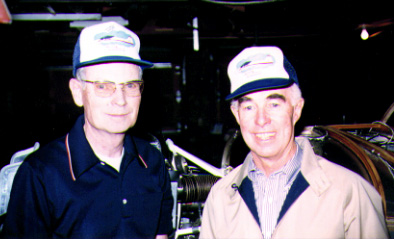
Dan Garn and Wendell Taylor.
An AN4 bolt is good for 278 in/lbs in bending. That's the ultimate load. For design loads you divide by the 1.5 safety factor so that gives you 185 in/lbs. There is a one-inch spacing between the hinges, and with the control arm in the center, that puts the strength at about 360 lbs. There is a big difference in the strength of a bolt in bending and shear. Putting a bolt in bending is very poor design. Most of the bolts in the Falco are in double-shear, some are in single-shear, but I can't think of a single one that is in bending.
I don't like coming down on Wendell and Dan. Clearly, they did not see any danger in it. But Dave Thurston is one of the most respected and capable aeronautical engineers in this country and when he calls something non-airworthy, I do not argue. There is nothing wrong with using a ball bearing in a control system. Many designers prefer them, but I could not see any reduction in friction. The proper fix for this is to install a pressed-in cadmium-plated steel or bronze bushing in P/N 745 just like the original design but long enough so that the bushing meets the inner race of the ball bearing. With the bolt torqued down, the design is actually stronger than the original design. Sorry guys, but this one could kill you.
This all has a happy ending. As we go to press, Wendell says that the hinge bolt has been changed. Happy flying!
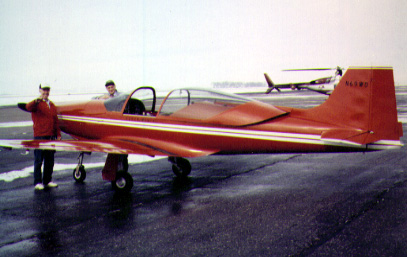
The Falco was subsequently painted with white stripes.